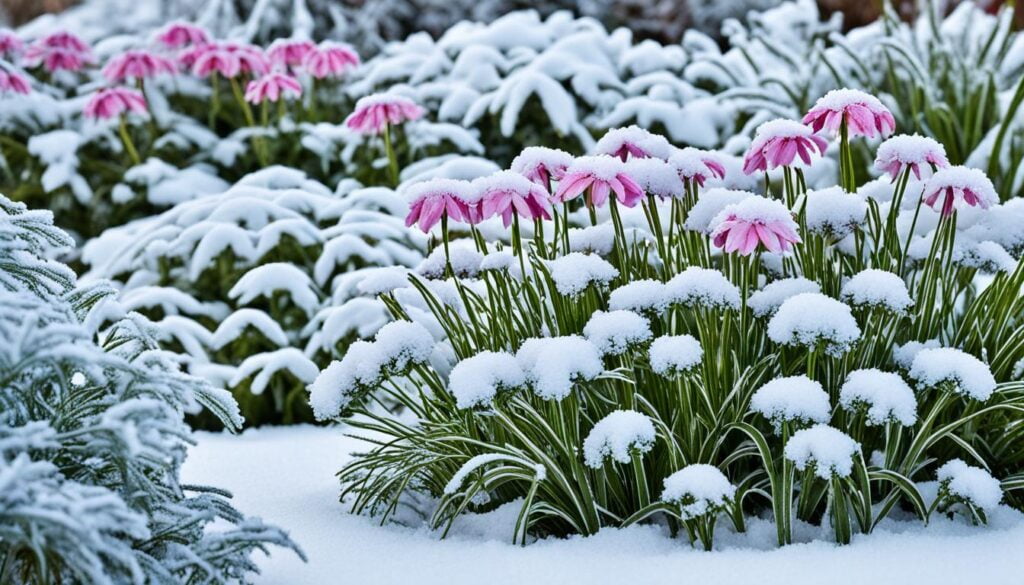I love the quiet beauty of a winter garden. Winter doesn’t mean nature stops showing off. Instead, it brings a subtler, enchanting display of flowers. These plants bloom resolutely, adding color to the frost.
From Winter Jasmine’s sunny beauty to Mahonia’s bright yellow, these plants are more than decorations. They are my winter friends, showing life’s persistence. I’m excited to share tips for your own winter garden.
Key Takeaways
- Discover plants like Hellebores that thrive across a broad spectrum of USDA Hardiness Zones from 4 to 91.
- Learn how to incorporate Mediterranean White Heather, which flourishes in the milder climates of zones 6 to 101.
- Indulge in the beauty and charm of Snowdrops, designed to withstand colder environments, from zones 3 to 81.
- Embrace winter favorites like Camellias, that offer dramatic seasonal color in zones 7 to 91.
- Explore a palette of floral colors with Grape Hyacinth and Winter Heath plants, as well as the rich textures of Ornamental Cabbage and Kale2.
- Consider environment-friendly options like Winter Aconites that attract pollinators and repel pests2.
- Adorn your garden with a variety of winter flowering annuals that require minimal care and provide maximum beauty3.
Embracing Color Through Winter Jasmine
When winter comes, the landscape often looks gray. But, Winter Jasmine brings a splash of color. Its bright, golden-yellow flowers are perfect for adding color to your winter garden45.
Bright Yellow Blooms to Warm Your Garden
Winter Jasmine’s bright flowers can make even the coldest day feel warmer. It starts blooming in late December and goes into early spring5. It’s tough and can handle frost, making it great for gardeners who want a lively garden in winter.
How to Group Winter Jasmine for Visual Impact
For those into container gardening, Winter Jasmine is a great choice. Plant it in containers to bring its beauty closer to your home or along paths. Grouping these shrubs makes them stand out, creating a beautiful winter focal point.
Place these groups at spots like entryways or garden bends. This way, every visitor gets a warm welcome, even on gloomy days. Its long blooming time keeps your garden colorful, offering joy and a peek at the vibrant seasons to come.
Adding Winter Jasmine to your garden or containers means spreading joy and beauty in winter. Let this flower turn your garden into a lively place with its yellow blossoms.
Intriguing Star-Shaped Charm of Glory of the Snow
The Glory of the Snow, or Chionodoxa, is a magical sight in early spring gardens. Their star-shaped flowers come in many colors like sky blue, sapphire, and indigo. They break through snow to welcome spring6. Perfect for rock gardens, they love well-draining soil and brighten any spot with color6.
Chionodoxa is key to a garden’s health and beauty. Its early flowers feed bees and butterflies, making it great for pollinators6. It’s also safe from deer and rodents, helping your garden stay pest-free6.
Chionodoxa is easy to care for. Put them in full sun to partial shade and they’ll spread, filling your garden with life6. They’re great for small spaces too, making balconies and patios look alive in spring6.
Adding Chionodoxa to your garden brings beauty and helps wildlife. It’s a mix of looks, function, and caring for the environment. Ideal for those who love perennials and annuals, these plants keep your garden vibrant early in spring6.
Elegant White Blossoms of Mediterranean White Heather
The Mediterranean White Heather, or Erica, brings a magical touch to gardens in the cold months. Its white blooms appear from fall to winter, making it perfect for year-round floral arrangements7. This plant thrives in USDA Hardiness Zones 6 to 10, offering a beautiful contrast in winter gardens. It represents deep flower meanings and symbolism.
When choosing a spot for White Heather, pick a place that highlights its beauty and meets its growth needs. It loves well-drained, acidic soil, similar to what rhododendrons and azaleas prefer. This makes these plants great friends for a beautiful garden8.
Evergreen Shrubs for Depth in Your Garden
Adding Mediterranean White Heather to your garden adds beauty and depth. Its evergreen nature keeps your garden looking lush all year. It’s a great backdrop for early spring flowers or a nice contrast to other plants.
Choosing the Right Spot for White Heather
For the best look, place White Heather in a spot with partial sunlight and wind protection. These plants can handle winter and come back year after year. Pairing them with plants like camellias or blueberries adds more beauty and extends the blooming season8.
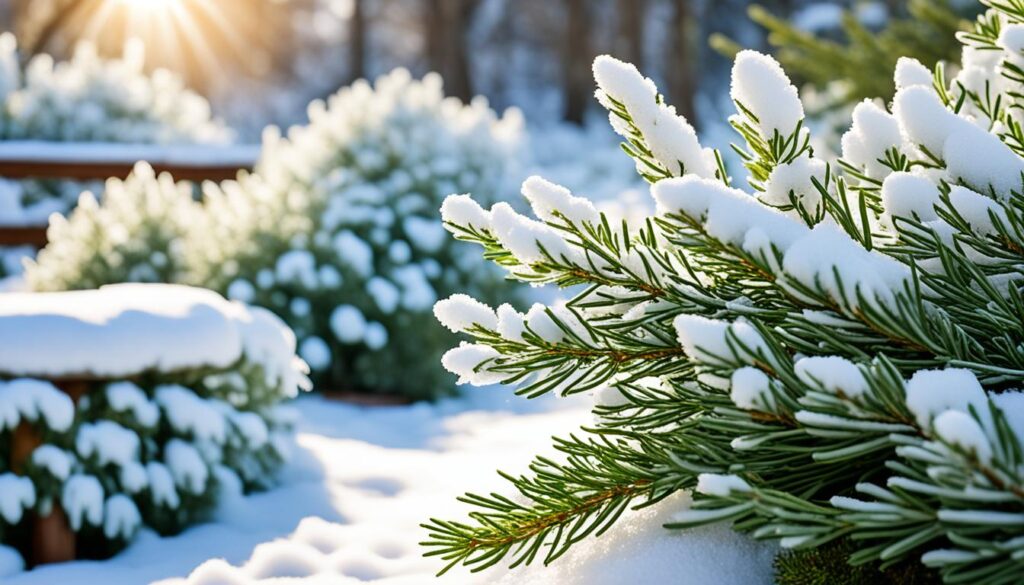
Lenten Rose Hellebores: A Perennial Favorite
I love plants that can handle tough times and still look great. The Lenten rose, or Hellebores, is one such plant. It shines in the late winter garden, showing off its beauty and strength.
The Lenten rose belongs to a group of evergreen perennials with about 20 species. They come from Europe and Asia and are popular in many U.S. gardens, especially in USDA Hardiness Zones 4 to 9. These plants grow into clumps, reaching 18” to 24” tall and 24” to 30” wide. Their glossy, deep green leaves provide a beautiful backdrop for their colorful flowers9.
These perennials are known for their early spring flowers and can produce up to 50 flowers per plant9. Their flowers come in a wide range of colors, from pure white to plum, pink, red, yellow, green, and cream9. This variety makes them perfect for different garden styles and cut flower arrangements.
| Feature | Description |
|---|---|
| Size | Typically 9-18″ tall, 12-24″ wide10 |
| Sun Exposure | Dappled sun to part shade10 |
| Soil pH | Neutral to slightly alkaline (7.0-8.0)10 |
| Bloom Time | Winter to early spring10 |
| Flower Color | Green, white, red, purple, pink, yellow10 |
In colder areas, knowing that these perennials can thrive in USDA Zones 3 to 4 is great. Plants like ‘Winter Dreams’ and ‘Snowbells’ show their hardiness. They also do well in dry soil, making them easy to care for.
In conclusion, the Lenten rose is more than just a plant. It’s a resilient, vibrant addition to any winter garden. It’s perfect for both new and experienced gardeners. Its wide climate tolerance and beautiful flowers make it essential for cut flower care and perennial gardens.
Crocus Corms: Harbingers of Spring
I look forward to spring, not just for the warm weather but for the crocus corms in my garden. These early bloomers signal the end of winter. They are perfect for container gardening with flowers.
Planting crocus corms in containers brightens up patios and balconies. They are easy to care for, making them great for beginners. In the U.S., over 30 types of crocus flowers bloom early, covering the ground in color11.
Crocus corms are not bulbs but solid structures that store nutrients for the flower. They thrive in USDA Hardiness Zones 4 to 812. In the fall, plant them in well-drained soil, in full sun to partial shade. They’re perfect for gardens and containers, offering a variety of colors from white to purple1113.
- Depth and Spacing: Plant crocus corms 3 inches deep and 4 inches apart for best growth13.
- Companion Planting: Mix crocus with low groundcovers like Ajuga or creeping thyme for a fuller look12.
- Bloom Time: They bloom early, often before other flowers start to show11.
For a stunning spring display, plant different crocus types with early bloomers like Galanthus nivalis. This staggered planting ensures a long bloom period from late winter to spring13. Crocus are also used in saffron production13.
Gardening with crocus is a beautiful way to welcome spring. Whether in the ground or pots, these corms are easy to care for. They’re a great addition to any flower gardening tips guide. Enjoy the beauty of early spring with these amazing flowers!
Sweetly Scented Daphne Shrubs
Walking through my winter garden, I’m greeted by the sweet smell of Daphne odora. This shrub is a must-have for winter gardens, thanks to its lovely scent and delicate flowers. It’s a favorite among those who love the meanings and symbolism of flowers.
Why Daphne Deserves a Place in Your Winter Garden
Daphne odora blooms in late winter and into March, offering weeks of fragrance and beauty14. It’s perfect for pollinator gardens because it blooms when pollinators need it most14. Plus, its scent is linked to welcome and kindness in flower language, adding depth to your garden.
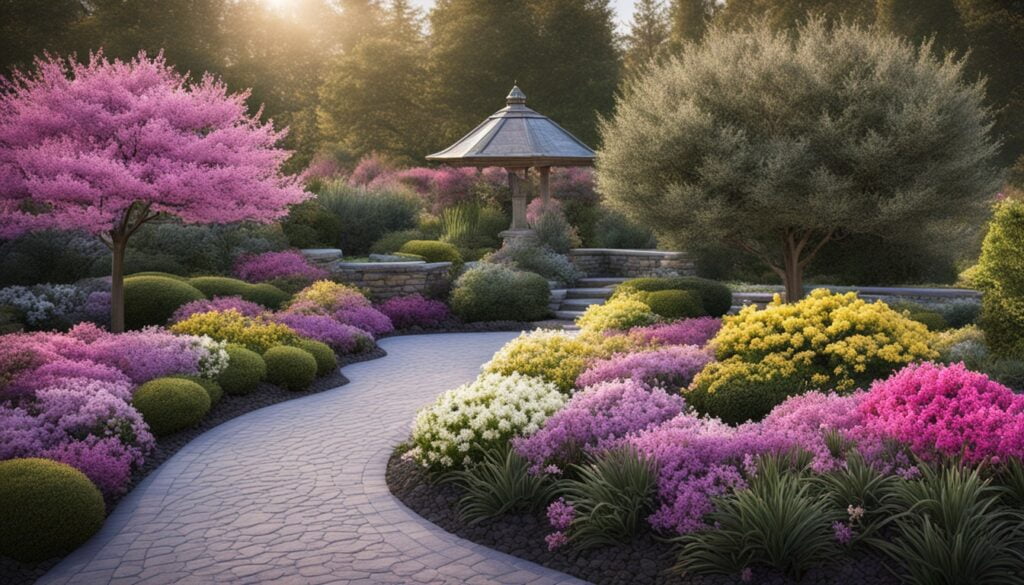
Delicate Flowers for Warmer Climates
In USDA Hardiness Zones 7 to 9, Daphne odora shines. It likes partial shade to protect its leaves from the intense afternoon sun14. But it still needs enough light to bloom well15. Varieties like ‘Aureomarginata’ and ‘Perfume Princess’ add color and variety to winter gardens14.
| Cultivar | Leaf Variegation | Flower Color | Fragrance Strength |
|---|---|---|---|
| ‘Aureomarginata’ | Gold-Edged | Pink | Moderate |
| ‘Marianni’ | Yellow-Striped | White | Mild |
| ‘Perfume Princess’ | Plain Green | Pink to Purple | Strong |
| ‘Perfume Princess White’ | Plain Green | White | Strong |
Daphne shrubs need careful attention. They do well in well-draining soil and need regular water, especially in winter to prevent root rot14. Pruning after blooming helps keep them looking great and stops them from growing inward14. It’s best to plant them where they’ll stay, as they don’t move well14.
Having Daphne in your garden shows you value beauty and the deeper meanings of flowers. They’re essential for pollinator gardens and add a special touch to your garden’s design.
Galanthus Snowdrops: Tiny Harbingers of Spring
As winter’s chill starts to fade, Galanthus snowdrops signal spring’s arrival. These Garden Flowers brighten the winter scene with their white blooms. They push through frozen soil to flower. Snowdrops are perfect for Container Gardening with Flowers, fitting well in rock gardens and woodlands.
Galanthus nivalis, a common snowdrop type, starts to grow in mid-December. They can bloom as early as mid-January, continuing until late March in colder areas16. They thrive in USDA Hardiness Zones 3 to 8. Under deciduous trees or in containers, they add beauty to gardens.
Planting Snowdrops for Early Spring Joy
I love planting snowdrops in the fall for early spring beauty. They prefer moist soil and good drainage16. Plant them three inches deep in small clumps for best health and a stunning display17.
Designing with Snowdrops in Rock Gardens
Snowdrops look magical in masses, creating a white carpet in rock gardens. Galanthus elwesii can grow up to 25 cm, fitting well among rocks16. Adding them with moss-covered stones and other early bloomers creates a layered garden look.
| Characteristic | Galanthus nivalis | Galanthus elwesii |
|---|---|---|
| Height | Up to 15 cm | Up to 25 cm |
| Blooming Period | Mid-January to late March | November to early spring |
| Leaf Type | Thin | Wider, fold around each other |
| Popular Use | Under trees, shrubs | Rock gardens, alpine setups |
| Inner Tepals Markings | Typical green or plain | Green, sometimes with yellow16 |
Snowdrops bring warmth and hope as winter ends. Adding them to gardens, in beds or containers, starts the year with beauty1617. These small flowers can turn any garden into a spring wonderland.
Winter-Blooming Camellia Varieties
As winter comes, we look for color in our gardens. Camellias, especially the winter types, bring life with their vibrant colors. They’re key for floral arrangements and as perennials and annuals that come back every year.
Add Color and Drama to the Winter Landscape
Camellias, like Camellia japonica, bloom from late December to March, brightening winter18. Each flower adds to a display that lasts over six weeks, thanks to their many buds19. The contrast of their glossy leaves and delicate petals is stunning in winter.
Selecting the Right Camellia for Your Garden
Choosing the right Camellia is key for growth and blooms. Types like Kramer’s Supreme and Nuccio’s Gem work well in Zones 8 to 10, offering beauty and toughness18. For cooler Zone 6, the Spring’s Promise Ice Angels® Camellia is a great choice18.
Think about the size and how they bloom when adding Camellias to your garden. Smaller ones like Camellia sasanqua ‘Shishi Gashira’ fit well in small spaces19. Bigger ones, like Camellia sasanqua ‘Apple Blossom’, grow up to 10 feet and are great for screens or backgrounds19.
Camellias need moist, acidic soil and protection from cold winds. They do best in places that stay warm, with some needing cover below 15°F20. Feed them with Holly-Tone in early spring and mid-fall for best blooms and soil health20.
With over 30,000 types, there’s a Camellia for every gardener wanting winter color20. Whether you pick a classic or a new breed, these plants will make your garden a winter wonderland.
Bright Berries of Winterberry Shrub
The Winterberry shrub shines brightly in the cold months, offering more than just beauty. As a flower gardening expert, I see it as a key plant for winter landscapes. Its bright red berries are a hit in cut flower arrangements, adding joy to the cold days.
Found in North America, the Winterberry holly thrives in many climates, from USDA Hardiness Zones 3 to 92122. It’s perfect for gardeners wanting winter color. Male Winterberries like Apollo and Jim Dandy help pollinate female plants, ensuring plenty of berries23.
For best results, place male plants 50 feet from female ones to help pollination2122. Each plant needs four hours of sunlight to produce the berries. Birds love these berries in winter, especially after they soften from freezing and thawing21.
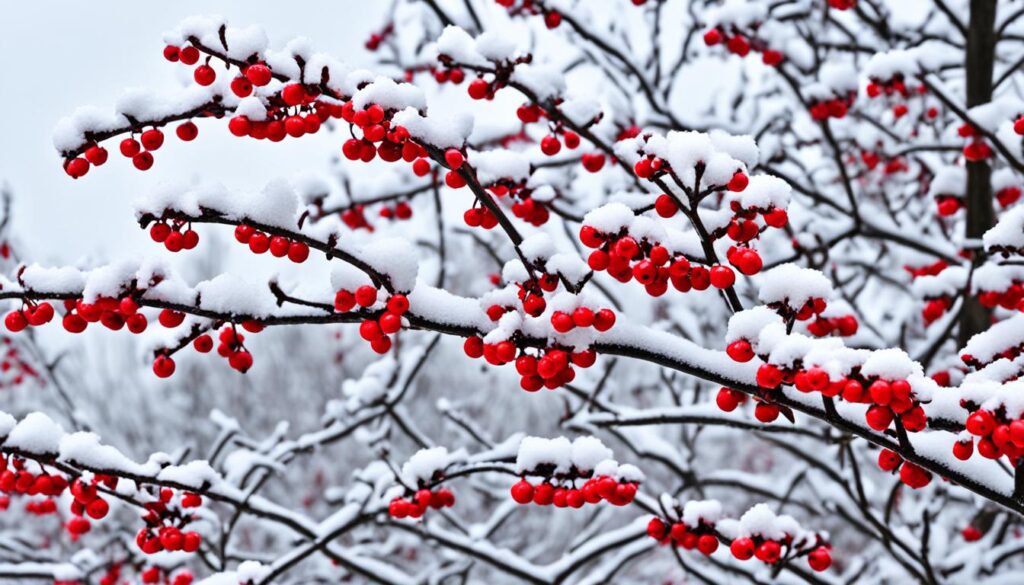
These berries are a big deal in cut flower arrangements, especially at Christmas. They come in red, orange, and yellow, adding variety to your garden23.
Pruning these shrubs is easy, which helps them produce more fruit. They bloom on old wood. Deer don’t like these berries, making them great for areas with wildlife issues21.
For more tips on winter gardening, check out this resource on winter gardening.
Planning your garden for winter? Add a Winterberry for a beautiful view and practical benefits. Its hardiness and bright colors make it a top choice for winter gardens.
Textural Wonders: Ornamental Cabbage and Kale
Ornamental cabbage and kale add a stunning look to container gardening with flowers and pollinator gardens. They are loved for their beautiful leaves and can handle cold weather. This makes them perfect for winter gardens in many places.
These plants keep their bright colors even when it gets cold, showing off shades of purple, pink, and white. Ornamental kale and cabbage make fall pot arrangements look great with their colors. Plants like Ruby Queen and Osaka Red cabbages get even more colorful in the cold242526.
In pollinator gardens, these plants are great for keeping gardens looking good in late fall and winter. The Redbor kale, with its purple-red leaves, catches the eye and adds depth to the garden25.
These ornamentals are tough and love sunlight or a bit of shade. They really show their colors when it stays cool at night. This makes them a top pick for gardeners wanting a lively garden in the cold months26.
| Variety | Leaf Color | Ideal Conditions |
|---|---|---|
| Osaka Red | Deep Cerise Pink | Cool temperatures, regular watering |
| Ruby Queen | Shades of purple and pink | Rich, well-drained soil with organic compost |
| Redbor Kale | Purple-Red Frilly Leaves | Sun to partial shade, requires moist soil |
These plants are easy to care for, even for busy people. They need good soil and do well with slow-release fertilizers and regular water-soluble feedings. This keeps them looking great all season25.
Ornamental kale and cabbages are a must-have for gardeners. They add beauty and benefits to container gardens and pollinator-friendly areas. Their unique textures and colors make gardens lively, even in the cold.
Adding Sparkle with Mahonia’s Yellow Blooms
When winter comes, Mahonia’s bright yellow flowers add color to the garden. Known as Oregon Grape Holly, this shrub is tough and brings life and joy with its flower meanings and symbolism. It’s a favorite in garden flowers in cold areas27.
Mahonia grows from Alaska’s sunny coasts to California’s shaded gardens, showing its toughness and flexibility27. While many plants hide in winter, Mahonia’s yellow flowers bloom from November to sometimes into the New Year28. These flowers are not just pretty; they also feed bees when they need it most27.
Mahonia is more than just a pretty plant. Birds like blackcaps and thrushes eat its berries in the cold months when food is hard to find28. The berries start green and turn to a shiny blue-black, with a white spot28.
Some Mahonia plants can grow as tall as three meters, making them a big part of any winter garden28. It looks great on its own or with other plants that stay green in winter. Mahonia’s unique leaves and shape add beauty and structure to the garden.
| Feature | Description |
|---|---|
| Native Range | Western North America, from Alaska to California27 |
| Flowering Period | November to February27 |
| Height at Maturity | Up to 7 feet27 |
| Berry Characteristics | Size of a blackcurrant, turns blue-black with white bloom as they mature28 |
| Wildlife Benefit | Provides nectar for bees; berries are eaten by birds2827 |
Adding Mahonia to your garden brings color and life in winter. It also helps local wildlife, showing the true beauty and usefulness of garden flowers.
Scilla’s Blue Jewels in the Winter Garden
As winter comes, adding Scilla to your garden makes the cold season bright with blue colors. These perennials and annuals bring joy with their striking colors. They bloom early in spring, offering a beautiful display.
Creating Drifts of Color with Siberian Scilla
The Siberian Scilla (Scilla siberica) blooms in northern gardens with jonquil daffodils in April29. These flowers look great in rock gardens or as borders, creating a colorful sweep. They grow easily at the edge of woods and spread on their own, making your garden more beautiful each year29.
Scilla’s Naturalizing Effects in the Garden
Scilla types like the tall Scilla siberica ‘Spring Beauty’ grow 10-12cm tall with blue bells30. They’re great for spreading in different garden spots. This makes your garden look better and helps pollinators by offering food and shelter.
Scilla fits well in many garden spots. For example, Scilla mischtschenkoana ‘Tubergeniana’ blooms early, adding blue color in February30. Spread them in tall grass for a ‘millefiori’ effect in spring, creating a beautiful floral arrangement that changes with the seasons.
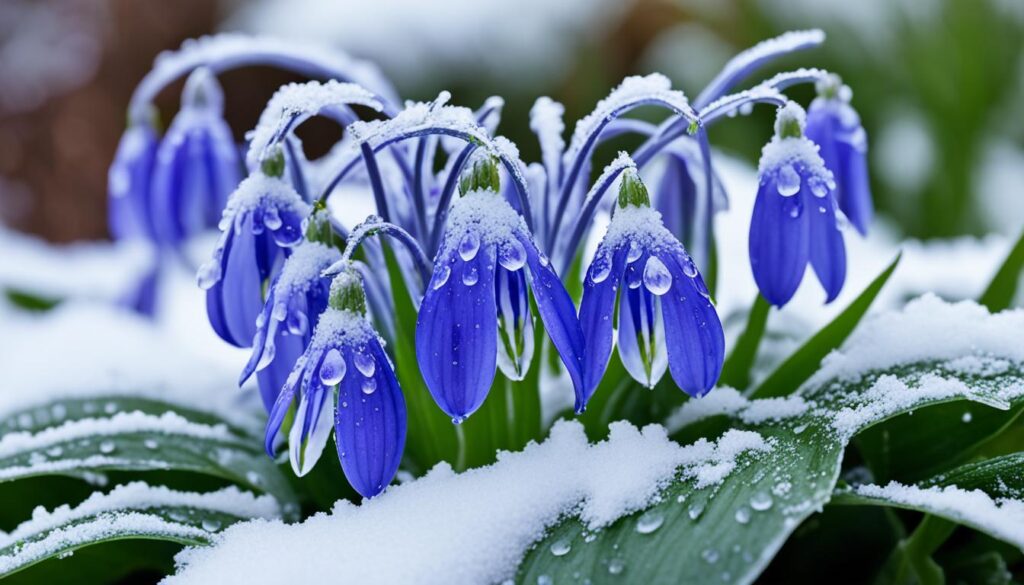
Adding Scilla to your garden means a stunning show every year. These plants are easy to care for and make a big impact. They’re perfect for both new and experienced gardeners who want to brighten their winter and spring gardens.
Breathtaking Pieris Shrubs in the Shade
I love sharing tips on flower gardening, especially about plants that do well in shade. Pieris, or Lily of the Valley shrubs, are perfect for adding beauty to shady spots in your garden.
Lily of the Valley Shrub: Late Winter Blooming
Pieris blooms in late winter, surprising you when most plants are asleep. They’re tough against cold and deer, and their flowers are sweet and full of nectar. These flowers attract pollinators early in the season31. They come in white to deep rose, adding color to your garden31.
Pieris: The Shade Lover With Cascading Clusters
For those into container gardening, Pieris is a great choice. Its flowers and leaves add beauty and life to containers. ‘Mountain Snow’ is great for full shade and fights pests and diseases32. Pieris japonica ‘Variegata’ has leaves with cool patterns, making any shaded area look better32.
Exploring Pieris shows how well they fit into shady spots. These shrubs make shaded areas look good all year. Adding Pieris to your garden or containers will make your garden stand out.
Colorful Winter Pansies: A Garden Flowers Delight
I love exploring the world of pollinator gardens. They’re not just beautiful but also help nature. Pansies, known as Viola x wittrockiana, light up our gardens with colors from deep blue to warm yellow33.
These flowers bloom from fall to early spring, adding color for a long time3433. They grow well in USDA zones 6 to 10 and can even peek through light snow. This brings joy to landscapes that seem dead34. Pansies symbolize love and admiration, showing it with their heart-shaped petals that look up at the sky.
- Pansies need full to partial sun and well-drained soil with organic compost for growth3435.
- Deadheading helps them bloom more, sometimes up to 600 flowers per plant, making gardens vibrant35.
- Pansies are important for winter pollinators, offering food when few flowers bloom33.
When adding Pansies to your garden, think about the colors and their meanings. Red and white Pansies say love and purity, while purple shows royalty and admiration35. This makes gardening more meaningful and enjoyable, especially in winter.
To care for Pansies, make sure the soil drains well and protect them from pests like aphids and slugs35. A well-thought-out Pansy garden is beautiful and supports local ecosystems, brightening winter days.
Conclusion
Reflecting on winter flowers shows how gardening can boost our well-being. Growing flowers like marigolds, pansies, zinnias, and sunflowers is more than a hobby. It helps reduce stress, anxiety, and depression, creating a mental health sanctuary36. These plants also lower blood pressure and cut the risk of heart disease36.
These winter blooms are crucial for our ecosystem, supporting pollinators. They attract bees and butterflies, which are key for plant growth and diversity36. Plus, they clean the air by taking in carbon dioxide and releasing oxygen, improving air quality36. With over 500 types of flowers, they play a big role in our lives, from religious rituals to showing love37.
Learning about flower gardening and cut flower care lets us keep our gardens lively, even in winter. Roses, for example, are loved worldwide and have many uses, from weddings to expressing deep feelings37. By growing these winter flowers, we boost our happiness and make our homes and neighborhoods more beautiful37. With every seed we plant and every bloom we care for, we celebrate growth, life, and nature’s resilience.
FAQ
What are some winter garden flowers that add color during the cold months?
How do I group Winter Jasmine for maximum visual impact in my garden?
Can I plant Glory of the Snow to create a pollinator garden in winter?
What kind of floral arrangements can I make with Mediterranean White Heather?
How do I care for cut Hellebores in floral arrangements?
Are Crocus easy to grow in container gardens?
Why should I include Daphne shrubs in my winter garden?
When is the best time to plant Snowdrops to ensure they bloom in early spring?
How do I choose the right Camellia variety for my winter-blooming garden?
What are the benefits of having Winterberry in my winter garden?
Can Ornamental Cabbage and Kale withstand freezing temperatures?
What symbolism do Mahonia’s yellow blooms carry?
How do I create drifts of color with Siberian Scilla in my garden?
Is Pieris suitable for shady winter garden areas?
What makes Pansies an ideal choice for winter gardens?
Source Links
- These Colorful and Hardy Plants Are Perfect for Creating a Vibrant Winter Garden
- 22 Winter Flowers That Actually Love the Cold
- 15 Winter Annuals That Will Fill Your Garden With Beautiful Colors
- Blossoms Beyond Frost: Embracing the Resilience of Frost-Resistant Pla
- Embracing winter blooms
- 14 Captivating Facts About Chionodoxa
- Hellebores and Heather — Contained Creations
- Plants That Grow With Heather – Tips On Companion Planting With Heather
- Lenten Rose, <em>Helleborus</em> ×<em>hybridus</em>
- How To Grow And Care For Lenten Roses And Other Hellebore Varieties
- Snow Crocus
- Autumn Crocus, <em>Colchicum</em> spp.
- February 2016 Plant of the Month: Crocus | UT Gardens – The State Botanical Garden of Tennessee
- Amazing Scent & Winter Blooms of the Daphne odora Plant – Dennis’ 7 Dees | Landscaping Services & Garden Centers
- The best daphne for year-round colour and scent
- Galanthus (Snowdrops) Harbinger of Spring
- Snowdrops are harbingers of spring
- Best Winter-Blooming Camellias For A Winter Floral Fix
- Winter-Blooming Camellia for Effortless, Brilliant Color – Dennis’ 7 Dees | Landscaping Services & Garden Centers
- A Guide to Winter Blooming Camellias – Garden Savvy Gardening Blog
- Winterberry Holly: The Ultimate Guide to Getting Colorful Berries
- Winterberry Holly Brightens the Winter Landscape
- Winterberry – A Holly Like No Other – Norfolk Botanical Garden
- The Prep
- Ornamental cabbage, kale make excellent winter color
- Ornamental Cabbage and Kale – Green Thumb Nursery
- Oregon Grape Holly
- Mooching about by mahonia
- Spring Blues – North Country Reflections
- How to grow scilla
- A Complete Guide to Growing Japanese Pieris – Garden Design
- 6 Spectacular Shade Loving Plants For Your Garden
- Pansies 101 — James Farmer
- 16 Winter Flowers for a Colorful Cold-Weather Garden – Garden Design
- Pansies: Your Ticket to Year-Round Garden Delight | Wonder
- The Benefits of Cultivating a Flower Garden – Island Gardens
- Flowers Essay for Students and Children | 500 Words Essay
